Risk Management Case: Analysis of Waterfall Train Accident, NSW
VerifiedAdded on 2023/06/07
|10
|2283
|181
Case Study
AI Summary
This case study delves into the Waterfall train accident that occurred in New South Wales, Australia, in 2003, examining the various factors that contributed to the tragedy. The primary cause was identified as a faulty deadman's brake, compounded by poor maintenance, mechanical failures, and potential human error. The accident claimed seven lives and led to significant policy changes and safety practice improvements within the rail system. A detailed technical analysis and a Special Commission of Inquiry report highlighted the need for enhanced safety measures, including improved emergency escape systems and stricter maintenance protocols. This report explores the causes, consequences, and policy changes resulting from the accident, with a focus on safety and risk management. Desklib provides students access to similar case studies and solved assignments.

Running head: SAFETY AND RISK MANAGEMENT
Safety and Risk Management: Waterfall Train Accident, New South Wales
Name of the Student
Name of the University
Author Note
Safety and Risk Management: Waterfall Train Accident, New South Wales
Name of the Student
Name of the University
Author Note
Paraphrase This Document
Need a fresh take? Get an instant paraphrase of this document with our AI Paraphraser

1
SAFETY AND RISK MANAGEMENT
Table of Contents
1. Introduction......................................................................................................................2
2. Waterfall train accident new South Wales.......................................................................2
3. The Causes of the Accident: The Safety Breaches..........................................................3
4. Changes to Policies or Practise........................................................................................5
5. Conclusion.......................................................................................................................6
References............................................................................................................................8
SAFETY AND RISK MANAGEMENT
Table of Contents
1. Introduction......................................................................................................................2
2. Waterfall train accident new South Wales.......................................................................2
3. The Causes of the Accident: The Safety Breaches..........................................................3
4. Changes to Policies or Practise........................................................................................5
5. Conclusion.......................................................................................................................6
References............................................................................................................................8

2
SAFETY AND RISK MANAGEMENT
Waterfall Train Accident, New South Wales
1. Introduction
In the past years, there have been many cases of train accidents and train crashes in
Australia and in overseas that mainly occurred as a result of breaching the safety requirements
and rules. The report takes into consideration the Waterfall train accident of New South Wales
and discusses the number of reasons that contributed the train crash. The Waterfall rail accident
occurred on January 31, 2003 near Waterfall in New South Wales Australia. The accident gained
a considerable media coverage concerning its cause (Glendon & Evans, 2007). A number of
causes of the accident was speculated, the major one out of them being the excessive speed of the
train and poor maintenance (Donaldson, Edkins & Victoria, 2004). The report gives an overview
of the Waterfall rail accident and its causes and analyses the process by which similar rail
accidents can be prevented. The details of the Waterfall train accident are discussed in the
following paragraphs.
2. Waterfall train accident new South Wales
On January 31, 2003, a four car Tangara passenger train derailed in about 2 kilometres
south of the waterfall railway station. The details about this train accident were difficult to gather
as the train driver died in the accident and was not available to provide any concrete information
about the accident. The train guard failed to provide concrete evidence as well (McIntosh &
Edkins, 2007). Apart from that, the possibility of a significant mechanical malfunctioning was
not readily identifiable as well.
This was an accident associated with rail derailment. The derailment of a vehicle mainly
occurs when the trains run off from its rails. There are a number of reasons behind the derailment
SAFETY AND RISK MANAGEMENT
Waterfall Train Accident, New South Wales
1. Introduction
In the past years, there have been many cases of train accidents and train crashes in
Australia and in overseas that mainly occurred as a result of breaching the safety requirements
and rules. The report takes into consideration the Waterfall train accident of New South Wales
and discusses the number of reasons that contributed the train crash. The Waterfall rail accident
occurred on January 31, 2003 near Waterfall in New South Wales Australia. The accident gained
a considerable media coverage concerning its cause (Glendon & Evans, 2007). A number of
causes of the accident was speculated, the major one out of them being the excessive speed of the
train and poor maintenance (Donaldson, Edkins & Victoria, 2004). The report gives an overview
of the Waterfall rail accident and its causes and analyses the process by which similar rail
accidents can be prevented. The details of the Waterfall train accident are discussed in the
following paragraphs.
2. Waterfall train accident new South Wales
On January 31, 2003, a four car Tangara passenger train derailed in about 2 kilometres
south of the waterfall railway station. The details about this train accident were difficult to gather
as the train driver died in the accident and was not available to provide any concrete information
about the accident. The train guard failed to provide concrete evidence as well (McIntosh &
Edkins, 2007). Apart from that, the possibility of a significant mechanical malfunctioning was
not readily identifiable as well.
This was an accident associated with rail derailment. The derailment of a vehicle mainly
occurs when the trains run off from its rails. There are a number of reasons behind the derailment
⊘ This is a preview!⊘
Do you want full access?
Subscribe today to unlock all pages.

Trusted by 1+ million students worldwide
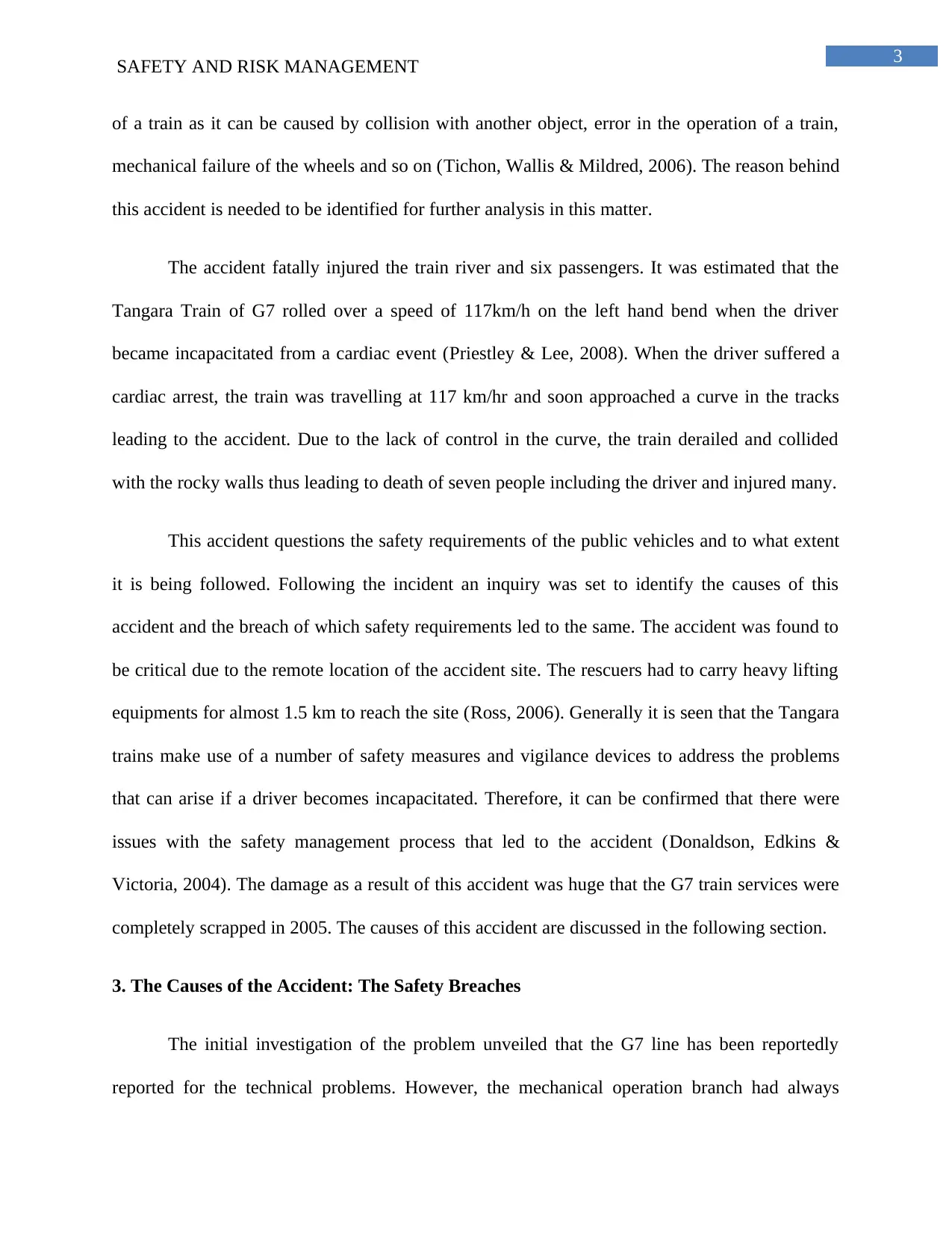
3
SAFETY AND RISK MANAGEMENT
of a train as it can be caused by collision with another object, error in the operation of a train,
mechanical failure of the wheels and so on (Tichon, Wallis & Mildred, 2006). The reason behind
this accident is needed to be identified for further analysis in this matter.
The accident fatally injured the train river and six passengers. It was estimated that the
Tangara Train of G7 rolled over a speed of 117km/h on the left hand bend when the driver
became incapacitated from a cardiac event (Priestley & Lee, 2008). When the driver suffered a
cardiac arrest, the train was travelling at 117 km/hr and soon approached a curve in the tracks
leading to the accident. Due to the lack of control in the curve, the train derailed and collided
with the rocky walls thus leading to death of seven people including the driver and injured many.
This accident questions the safety requirements of the public vehicles and to what extent
it is being followed. Following the incident an inquiry was set to identify the causes of this
accident and the breach of which safety requirements led to the same. The accident was found to
be critical due to the remote location of the accident site. The rescuers had to carry heavy lifting
equipments for almost 1.5 km to reach the site (Ross, 2006). Generally it is seen that the Tangara
trains make use of a number of safety measures and vigilance devices to address the problems
that can arise if a driver becomes incapacitated. Therefore, it can be confirmed that there were
issues with the safety management process that led to the accident (Donaldson, Edkins &
Victoria, 2004). The damage as a result of this accident was huge that the G7 train services were
completely scrapped in 2005. The causes of this accident are discussed in the following section.
3. The Causes of the Accident: The Safety Breaches
The initial investigation of the problem unveiled that the G7 line has been reportedly
reported for the technical problems. However, the mechanical operation branch had always
SAFETY AND RISK MANAGEMENT
of a train as it can be caused by collision with another object, error in the operation of a train,
mechanical failure of the wheels and so on (Tichon, Wallis & Mildred, 2006). The reason behind
this accident is needed to be identified for further analysis in this matter.
The accident fatally injured the train river and six passengers. It was estimated that the
Tangara Train of G7 rolled over a speed of 117km/h on the left hand bend when the driver
became incapacitated from a cardiac event (Priestley & Lee, 2008). When the driver suffered a
cardiac arrest, the train was travelling at 117 km/hr and soon approached a curve in the tracks
leading to the accident. Due to the lack of control in the curve, the train derailed and collided
with the rocky walls thus leading to death of seven people including the driver and injured many.
This accident questions the safety requirements of the public vehicles and to what extent
it is being followed. Following the incident an inquiry was set to identify the causes of this
accident and the breach of which safety requirements led to the same. The accident was found to
be critical due to the remote location of the accident site. The rescuers had to carry heavy lifting
equipments for almost 1.5 km to reach the site (Ross, 2006). Generally it is seen that the Tangara
trains make use of a number of safety measures and vigilance devices to address the problems
that can arise if a driver becomes incapacitated. Therefore, it can be confirmed that there were
issues with the safety management process that led to the accident (Donaldson, Edkins &
Victoria, 2004). The damage as a result of this accident was huge that the G7 train services were
completely scrapped in 2005. The causes of this accident are discussed in the following section.
3. The Causes of the Accident: The Safety Breaches
The initial investigation of the problem unveiled that the G7 line has been reportedly
reported for the technical problems. However, the mechanical operation branch had always
Paraphrase This Document
Need a fresh take? Get an instant paraphrase of this document with our AI Paraphraser
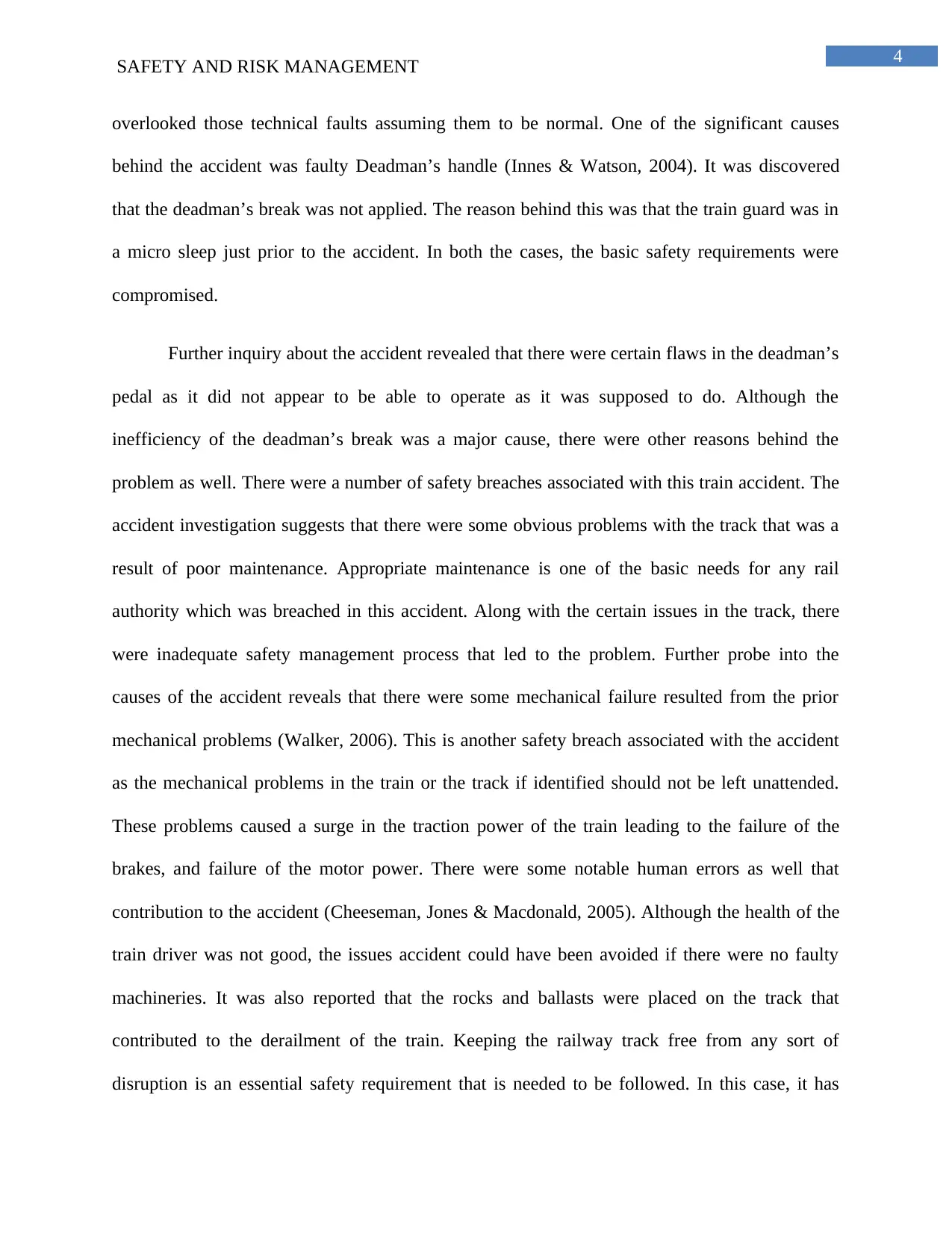
4
SAFETY AND RISK MANAGEMENT
overlooked those technical faults assuming them to be normal. One of the significant causes
behind the accident was faulty Deadman’s handle (Innes & Watson, 2004). It was discovered
that the deadman’s break was not applied. The reason behind this was that the train guard was in
a micro sleep just prior to the accident. In both the cases, the basic safety requirements were
compromised.
Further inquiry about the accident revealed that there were certain flaws in the deadman’s
pedal as it did not appear to be able to operate as it was supposed to do. Although the
inefficiency of the deadman’s break was a major cause, there were other reasons behind the
problem as well. There were a number of safety breaches associated with this train accident. The
accident investigation suggests that there were some obvious problems with the track that was a
result of poor maintenance. Appropriate maintenance is one of the basic needs for any rail
authority which was breached in this accident. Along with the certain issues in the track, there
were inadequate safety management process that led to the problem. Further probe into the
causes of the accident reveals that there were some mechanical failure resulted from the prior
mechanical problems (Walker, 2006). This is another safety breach associated with the accident
as the mechanical problems in the train or the track if identified should not be left unattended.
These problems caused a surge in the traction power of the train leading to the failure of the
brakes, and failure of the motor power. There were some notable human errors as well that
contribution to the accident (Cheeseman, Jones & Macdonald, 2005). Although the health of the
train driver was not good, the issues accident could have been avoided if there were no faulty
machineries. It was also reported that the rocks and ballasts were placed on the track that
contributed to the derailment of the train. Keeping the railway track free from any sort of
disruption is an essential safety requirement that is needed to be followed. In this case, it has
SAFETY AND RISK MANAGEMENT
overlooked those technical faults assuming them to be normal. One of the significant causes
behind the accident was faulty Deadman’s handle (Innes & Watson, 2004). It was discovered
that the deadman’s break was not applied. The reason behind this was that the train guard was in
a micro sleep just prior to the accident. In both the cases, the basic safety requirements were
compromised.
Further inquiry about the accident revealed that there were certain flaws in the deadman’s
pedal as it did not appear to be able to operate as it was supposed to do. Although the
inefficiency of the deadman’s break was a major cause, there were other reasons behind the
problem as well. There were a number of safety breaches associated with this train accident. The
accident investigation suggests that there were some obvious problems with the track that was a
result of poor maintenance. Appropriate maintenance is one of the basic needs for any rail
authority which was breached in this accident. Along with the certain issues in the track, there
were inadequate safety management process that led to the problem. Further probe into the
causes of the accident reveals that there were some mechanical failure resulted from the prior
mechanical problems (Walker, 2006). This is another safety breach associated with the accident
as the mechanical problems in the train or the track if identified should not be left unattended.
These problems caused a surge in the traction power of the train leading to the failure of the
brakes, and failure of the motor power. There were some notable human errors as well that
contribution to the accident (Cheeseman, Jones & Macdonald, 2005). Although the health of the
train driver was not good, the issues accident could have been avoided if there were no faulty
machineries. It was also reported that the rocks and ballasts were placed on the track that
contributed to the derailment of the train. Keeping the railway track free from any sort of
disruption is an essential safety requirement that is needed to be followed. In this case, it has
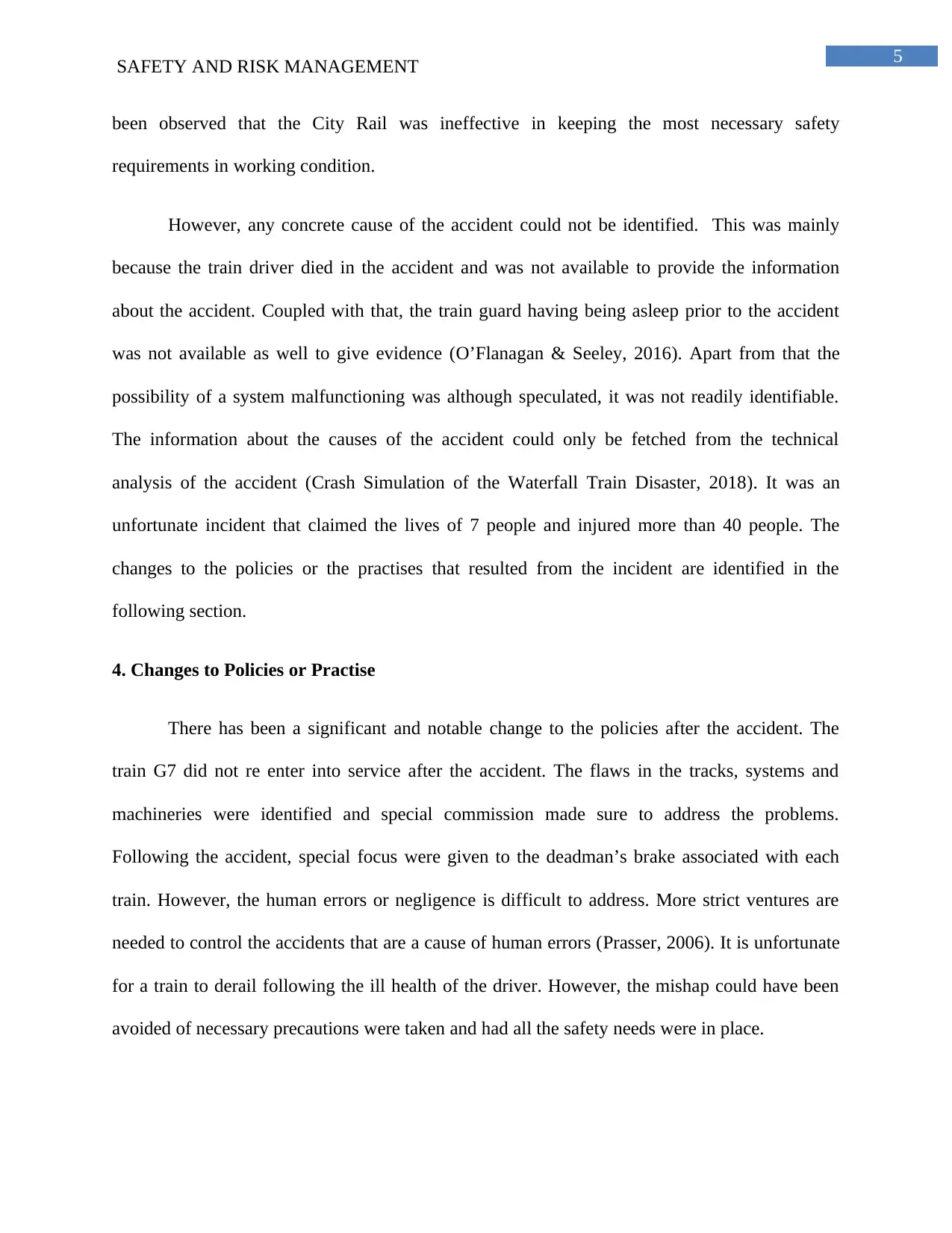
5
SAFETY AND RISK MANAGEMENT
been observed that the City Rail was ineffective in keeping the most necessary safety
requirements in working condition.
However, any concrete cause of the accident could not be identified. This was mainly
because the train driver died in the accident and was not available to provide the information
about the accident. Coupled with that, the train guard having being asleep prior to the accident
was not available as well to give evidence (O’Flanagan & Seeley, 2016). Apart from that the
possibility of a system malfunctioning was although speculated, it was not readily identifiable.
The information about the causes of the accident could only be fetched from the technical
analysis of the accident (Crash Simulation of the Waterfall Train Disaster, 2018). It was an
unfortunate incident that claimed the lives of 7 people and injured more than 40 people. The
changes to the policies or the practises that resulted from the incident are identified in the
following section.
4. Changes to Policies or Practise
There has been a significant and notable change to the policies after the accident. The
train G7 did not re enter into service after the accident. The flaws in the tracks, systems and
machineries were identified and special commission made sure to address the problems.
Following the accident, special focus were given to the deadman’s brake associated with each
train. However, the human errors or negligence is difficult to address. More strict ventures are
needed to control the accidents that are a cause of human errors (Prasser, 2006). It is unfortunate
for a train to derail following the ill health of the driver. However, the mishap could have been
avoided of necessary precautions were taken and had all the safety needs were in place.
SAFETY AND RISK MANAGEMENT
been observed that the City Rail was ineffective in keeping the most necessary safety
requirements in working condition.
However, any concrete cause of the accident could not be identified. This was mainly
because the train driver died in the accident and was not available to provide the information
about the accident. Coupled with that, the train guard having being asleep prior to the accident
was not available as well to give evidence (O’Flanagan & Seeley, 2016). Apart from that the
possibility of a system malfunctioning was although speculated, it was not readily identifiable.
The information about the causes of the accident could only be fetched from the technical
analysis of the accident (Crash Simulation of the Waterfall Train Disaster, 2018). It was an
unfortunate incident that claimed the lives of 7 people and injured more than 40 people. The
changes to the policies or the practises that resulted from the incident are identified in the
following section.
4. Changes to Policies or Practise
There has been a significant and notable change to the policies after the accident. The
train G7 did not re enter into service after the accident. The flaws in the tracks, systems and
machineries were identified and special commission made sure to address the problems.
Following the accident, special focus were given to the deadman’s brake associated with each
train. However, the human errors or negligence is difficult to address. More strict ventures are
needed to control the accidents that are a cause of human errors (Prasser, 2006). It is unfortunate
for a train to derail following the ill health of the driver. However, the mishap could have been
avoided of necessary precautions were taken and had all the safety needs were in place.
⊘ This is a preview!⊘
Do you want full access?
Subscribe today to unlock all pages.

Trusted by 1+ million students worldwide
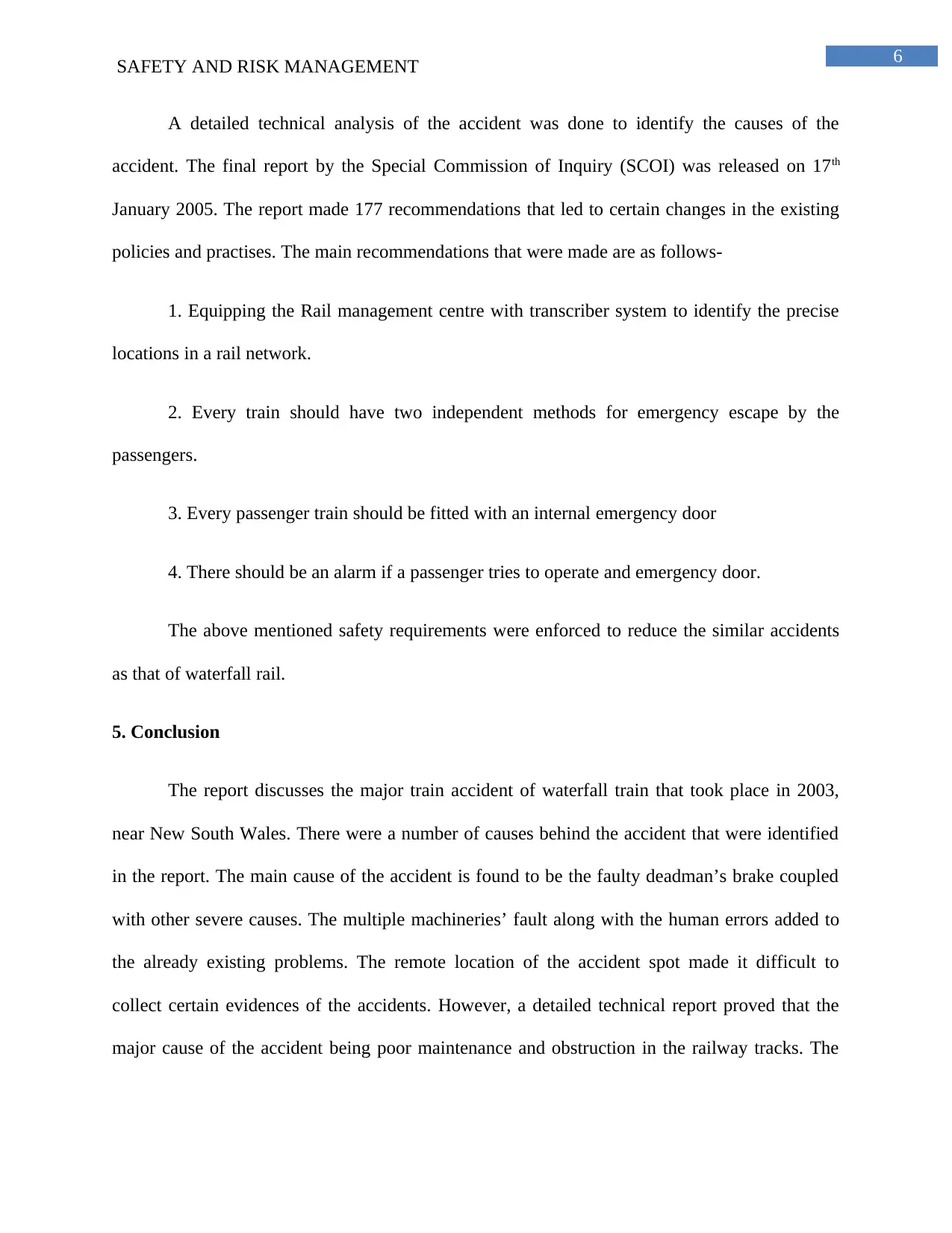
6
SAFETY AND RISK MANAGEMENT
A detailed technical analysis of the accident was done to identify the causes of the
accident. The final report by the Special Commission of Inquiry (SCOI) was released on 17th
January 2005. The report made 177 recommendations that led to certain changes in the existing
policies and practises. The main recommendations that were made are as follows-
1. Equipping the Rail management centre with transcriber system to identify the precise
locations in a rail network.
2. Every train should have two independent methods for emergency escape by the
passengers.
3. Every passenger train should be fitted with an internal emergency door
4. There should be an alarm if a passenger tries to operate and emergency door.
The above mentioned safety requirements were enforced to reduce the similar accidents
as that of waterfall rail.
5. Conclusion
The report discusses the major train accident of waterfall train that took place in 2003,
near New South Wales. There were a number of causes behind the accident that were identified
in the report. The main cause of the accident is found to be the faulty deadman’s brake coupled
with other severe causes. The multiple machineries’ fault along with the human errors added to
the already existing problems. The remote location of the accident spot made it difficult to
collect certain evidences of the accidents. However, a detailed technical report proved that the
major cause of the accident being poor maintenance and obstruction in the railway tracks. The
SAFETY AND RISK MANAGEMENT
A detailed technical analysis of the accident was done to identify the causes of the
accident. The final report by the Special Commission of Inquiry (SCOI) was released on 17th
January 2005. The report made 177 recommendations that led to certain changes in the existing
policies and practises. The main recommendations that were made are as follows-
1. Equipping the Rail management centre with transcriber system to identify the precise
locations in a rail network.
2. Every train should have two independent methods for emergency escape by the
passengers.
3. Every passenger train should be fitted with an internal emergency door
4. There should be an alarm if a passenger tries to operate and emergency door.
The above mentioned safety requirements were enforced to reduce the similar accidents
as that of waterfall rail.
5. Conclusion
The report discusses the major train accident of waterfall train that took place in 2003,
near New South Wales. There were a number of causes behind the accident that were identified
in the report. The main cause of the accident is found to be the faulty deadman’s brake coupled
with other severe causes. The multiple machineries’ fault along with the human errors added to
the already existing problems. The remote location of the accident spot made it difficult to
collect certain evidences of the accidents. However, a detailed technical report proved that the
major cause of the accident being poor maintenance and obstruction in the railway tracks. The
Paraphrase This Document
Need a fresh take? Get an instant paraphrase of this document with our AI Paraphraser

7
SAFETY AND RISK MANAGEMENT
accident led to the changes in certain policies and the practises which are further discussed in the
report.
SAFETY AND RISK MANAGEMENT
accident led to the changes in certain policies and the practises which are further discussed in the
report.
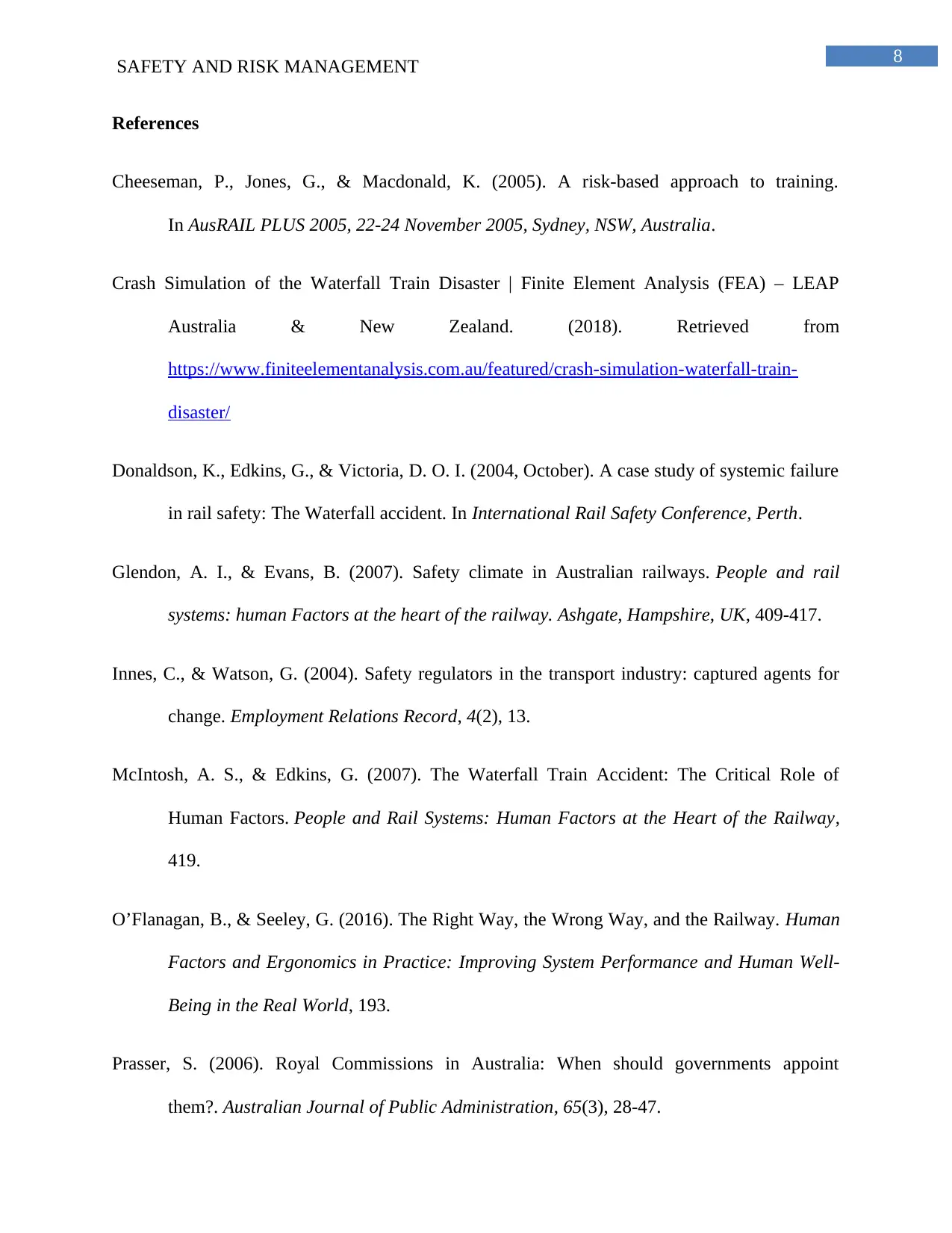
8
SAFETY AND RISK MANAGEMENT
References
Cheeseman, P., Jones, G., & Macdonald, K. (2005). A risk-based approach to training.
In AusRAIL PLUS 2005, 22-24 November 2005, Sydney, NSW, Australia.
Crash Simulation of the Waterfall Train Disaster | Finite Element Analysis (FEA) – LEAP
Australia & New Zealand. (2018). Retrieved from
https://www.finiteelementanalysis.com.au/featured/crash-simulation-waterfall-train-
disaster/
Donaldson, K., Edkins, G., & Victoria, D. O. I. (2004, October). A case study of systemic failure
in rail safety: The Waterfall accident. In International Rail Safety Conference, Perth.
Glendon, A. I., & Evans, B. (2007). Safety climate in Australian railways. People and rail
systems: human Factors at the heart of the railway. Ashgate, Hampshire, UK, 409-417.
Innes, C., & Watson, G. (2004). Safety regulators in the transport industry: captured agents for
change. Employment Relations Record, 4(2), 13.
McIntosh, A. S., & Edkins, G. (2007). The Waterfall Train Accident: The Critical Role of
Human Factors. People and Rail Systems: Human Factors at the Heart of the Railway,
419.
O’Flanagan, B., & Seeley, G. (2016). The Right Way, the Wrong Way, and the Railway. Human
Factors and Ergonomics in Practice: Improving System Performance and Human Well-
Being in the Real World, 193.
Prasser, S. (2006). Royal Commissions in Australia: When should governments appoint
them?. Australian Journal of Public Administration, 65(3), 28-47.
SAFETY AND RISK MANAGEMENT
References
Cheeseman, P., Jones, G., & Macdonald, K. (2005). A risk-based approach to training.
In AusRAIL PLUS 2005, 22-24 November 2005, Sydney, NSW, Australia.
Crash Simulation of the Waterfall Train Disaster | Finite Element Analysis (FEA) – LEAP
Australia & New Zealand. (2018). Retrieved from
https://www.finiteelementanalysis.com.au/featured/crash-simulation-waterfall-train-
disaster/
Donaldson, K., Edkins, G., & Victoria, D. O. I. (2004, October). A case study of systemic failure
in rail safety: The Waterfall accident. In International Rail Safety Conference, Perth.
Glendon, A. I., & Evans, B. (2007). Safety climate in Australian railways. People and rail
systems: human Factors at the heart of the railway. Ashgate, Hampshire, UK, 409-417.
Innes, C., & Watson, G. (2004). Safety regulators in the transport industry: captured agents for
change. Employment Relations Record, 4(2), 13.
McIntosh, A. S., & Edkins, G. (2007). The Waterfall Train Accident: The Critical Role of
Human Factors. People and Rail Systems: Human Factors at the Heart of the Railway,
419.
O’Flanagan, B., & Seeley, G. (2016). The Right Way, the Wrong Way, and the Railway. Human
Factors and Ergonomics in Practice: Improving System Performance and Human Well-
Being in the Real World, 193.
Prasser, S. (2006). Royal Commissions in Australia: When should governments appoint
them?. Australian Journal of Public Administration, 65(3), 28-47.
⊘ This is a preview!⊘
Do you want full access?
Subscribe today to unlock all pages.

Trusted by 1+ million students worldwide
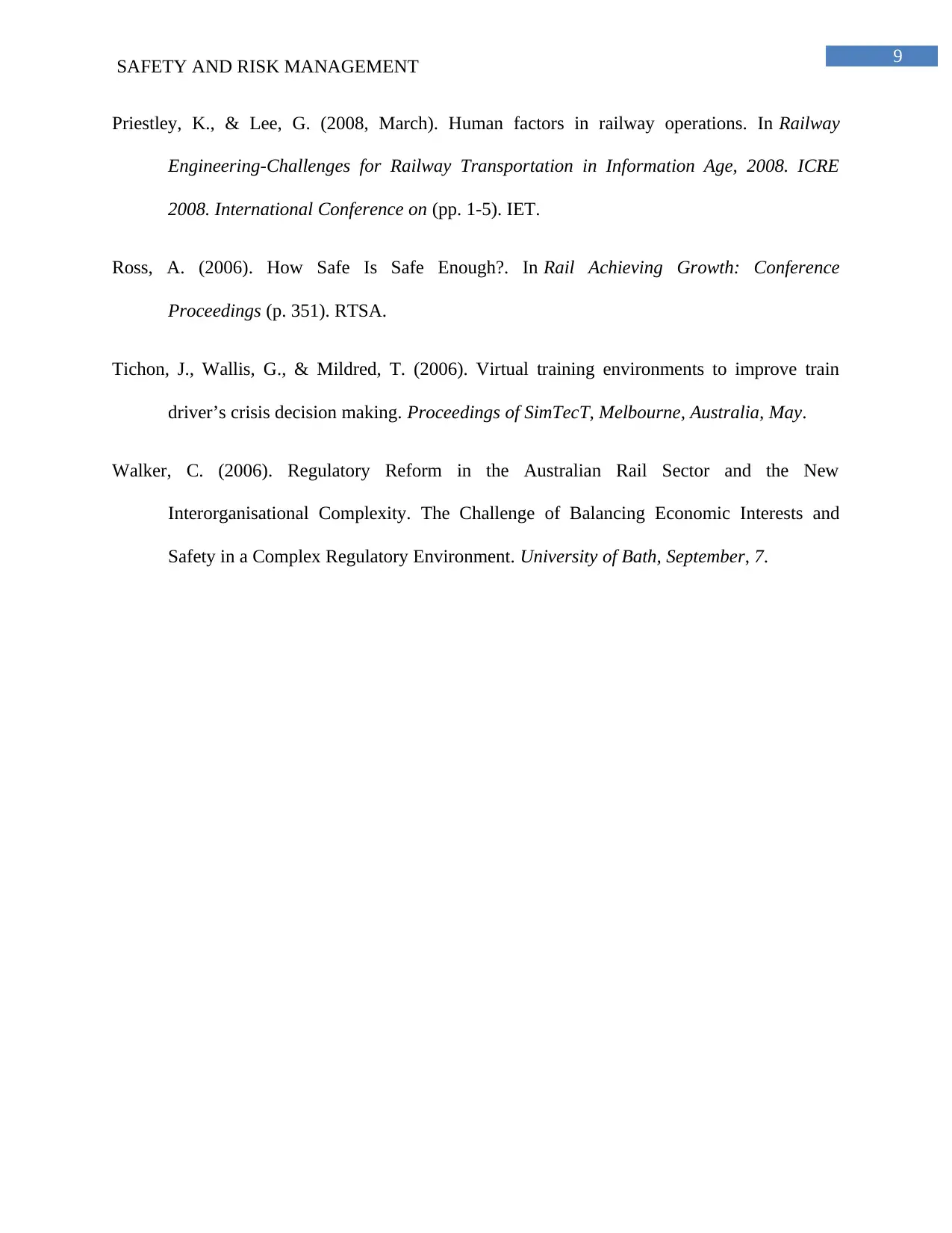
9
SAFETY AND RISK MANAGEMENT
Priestley, K., & Lee, G. (2008, March). Human factors in railway operations. In Railway
Engineering-Challenges for Railway Transportation in Information Age, 2008. ICRE
2008. International Conference on (pp. 1-5). IET.
Ross, A. (2006). How Safe Is Safe Enough?. In Rail Achieving Growth: Conference
Proceedings (p. 351). RTSA.
Tichon, J., Wallis, G., & Mildred, T. (2006). Virtual training environments to improve train
driver’s crisis decision making. Proceedings of SimTecT, Melbourne, Australia, May.
Walker, C. (2006). Regulatory Reform in the Australian Rail Sector and the New
Interorganisational Complexity. The Challenge of Balancing Economic Interests and
Safety in a Complex Regulatory Environment. University of Bath, September, 7.
SAFETY AND RISK MANAGEMENT
Priestley, K., & Lee, G. (2008, March). Human factors in railway operations. In Railway
Engineering-Challenges for Railway Transportation in Information Age, 2008. ICRE
2008. International Conference on (pp. 1-5). IET.
Ross, A. (2006). How Safe Is Safe Enough?. In Rail Achieving Growth: Conference
Proceedings (p. 351). RTSA.
Tichon, J., Wallis, G., & Mildred, T. (2006). Virtual training environments to improve train
driver’s crisis decision making. Proceedings of SimTecT, Melbourne, Australia, May.
Walker, C. (2006). Regulatory Reform in the Australian Rail Sector and the New
Interorganisational Complexity. The Challenge of Balancing Economic Interests and
Safety in a Complex Regulatory Environment. University of Bath, September, 7.
1 out of 10
Related Documents
Your All-in-One AI-Powered Toolkit for Academic Success.
+13062052269
info@desklib.com
Available 24*7 on WhatsApp / Email
![[object Object]](/_next/static/media/star-bottom.7253800d.svg)
Unlock your academic potential
Copyright © 2020–2025 A2Z Services. All Rights Reserved. Developed and managed by ZUCOL.





